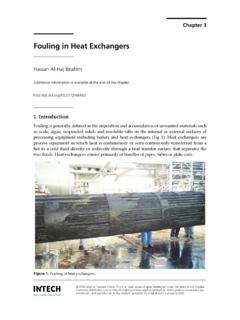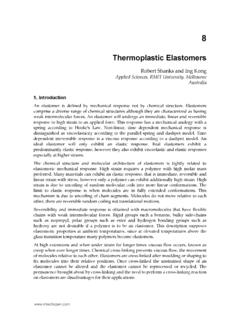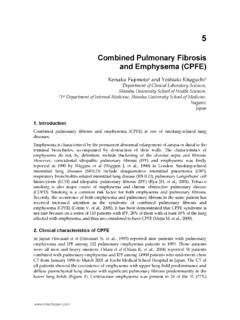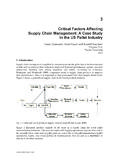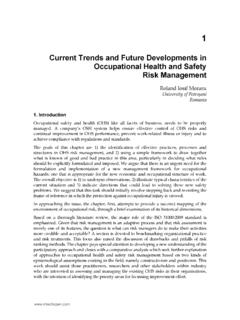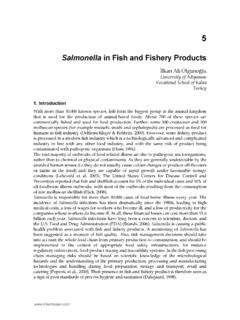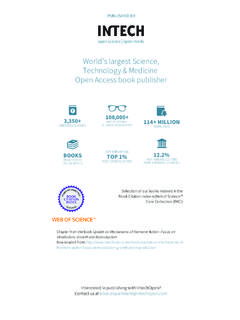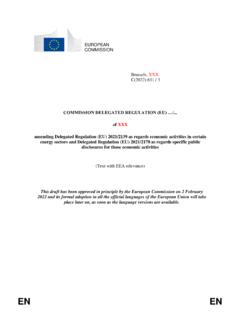Transcription of Flood Disaster Management in South Africa - IntechOpen
1 International Conference on Applied Life Sciences (ICALS2012)Turkey, September 10-12, 2012127 ISALS 2012 Zuma et al.; licensee InTech. This is an open access chapter distributed under the terms of the Creative Commons Attribution License ( ), which permits unrestricted use, distribution, and reproduction in any medium, provided the original work is properly Disaster Management in South Africa : legislative Framework and Current ChallengesBongumusa M. Zuma1,2,*, Catherine D. Luyt2, Tatenda Chirenda2, Roman Tandlich21 Institute for Environmental Biotechnology, Rhodes University, Grahamstown 6140, South Africa , tel. 00-27-46-622-2656, fax 00-27-46-603-7506, South Africa , *corresponding author, Email: 2 Environmental Health and Biotechnology Research Group, Division of Pharmaceutical Chemistry, Faculty of Pharmacy, Rhodes University, Grahamstown 6140, South Africa , tel.
2 00-27-46-603-8825, fax South Africa , the annual risk of flooding is % and the population vulnerability is high due to economic factors and geographical location. Before 1994 the Civil Protection Act No. 67 of 1977 governed Disaster Management , but its framework was inadequate as demonstrated by 104 deaths in Lainsburg floods of 1981. Thus a major push came towards improvement of insti-tutional capacity and the legislative framework to deal with Disaster Management after 1994. The 1996 Constitution of South Africa defined the law-making powers and the responsibilities at the national, provincial and local levels of government. The Disaster Management Act No. 57 of 2002 constitutes the institutional capacity at all levels of government. Response to flooding occurring between December 2010 and February 2011 is used to examine the functionality and drawbacks of the current Disaster Management system.
3 Impacts included damages to drinking water infra-structure, potential for cholera outbreaks and material losses. The response was adequate at the national level, but district municipalities struggled due to skills shortages and lack of Disaster Management structures. Remedial strategies are proposed using the current novel legislative tools. Research into vulnerabilities and risk must be strengthened. 1. IntroductionSouth Africa has semi-arid to arid climate and a total land area of million square kilometres [1]. It spans between latitudes of 35 and 22 South [2] with a population of million inhabit-ants [3]. Around 38 % of the population is concentrated on 2 % of land area in mainly urban centres [4] and the growth of the urban population places excess pressure on public services [4]; [5]. This potentially decreases Disaster resilience of households [6].
4 The country ranks among the bottom 30 nations from around the world with respect to the population s ability to provide sat-isfactory food and shelter at the household level and the Health Adjusted Life Expectancy stands currently at 48 years [7]. Vulnerability of the population is further indicated by the minimum living level [8]. Using the dependency ratios, the highest vulnerability is found in provinces of 128the Eastern Cape, KwaZulu-Natal, the North-West and Limpopo [6]. There have been 77 Flood Disaster events in South Africa between 1980 and 2010 [9]. A total of 1068 lost their lives in floods with the maximum of 506 in 1987 [9]. Based on these statistics, the risk of a Flood occurring in a given year can be calculated at %. In the context of climate change , the above mentioned facts pose problems in Disaster Management . Therefore the current legislative framework, examples of responses to recent Disaster and suggestions for improvement in Flood Disaster Management are presented in this paper.
5 2. National Disaster Management System of South Legal FrameworkPrior to 1994, Disaster Management activities were governed by the Civil Protection Act No. 67 of 1977 [10]. However, its framework proved inadequate as demonstrated by 104 deaths in Lains-burg floods of 1981 [11]. This resulted in the legislative and organisational efforts for system improvement and integration in Disaster Management . The 1996 Constitution of South Africa in Part A Schedule 4 defines that the role of the national, provincial governments and local govern-ments [12]. The first integrated policy on Disaster Management was the Green Paper on Disaster Management which was published as an extension of the Civil Protection Act [13]. Next was the White Paper on Disaster Management which enshrines the cooperative, proactive and inte-grated approach to Disaster risk Management , training and awareness through participation of all relevant stakeholders [14].
6 Specific goals of the White Paper included creation of the National Disaster Management Centre, improvement of Disaster prevention in the poor and disadvan-taged areas, creation of an adequate funding system; and information channels to communities [14]. The guiding principles of Disaster Management were then summarised and responsibilities defined in the Disaster Management Act No. 57 of 2002 [15].According to the DMA, President of the Republic of South Africa establishes the Intergovern-mental Committee on Disaster Management (IGCDM) as stated in chapter 2 section 4 paragraph 1a [15]. According to chapter 1 section 3, the President appointed the Minister of Cooperative Governance and Traditional Affairs to be in charge of the Disaster Management at the national government level [15]. Other members of the IGCDM include the National Ministers of Water and Environmental Affairs, Health, Defense, Finance, Presidency, Justice and Constitutional De-velopment; Defence; Education; Police; Provincial Ministers in charge of Disaster Management ; representatives of the South African Local Government Association (SALGA).
7 The IGCDM is ac-countable to the cabinet which it advises on Disaster Management according to chapter 2 section 4 paragraphs 2 and 3 [15]. At present, a surrogate, namely Joint Disaster Management Commit-tee covers the main responsibilities of the IGCDM [16]; [17].The National Disaster Management Centre (NDMC) is established in terms of chapter 3 part 1 section 8 of DMA [15]. Its functions include monitoring of disasters, mobilisation of resources and coordination and response to disasters; maintaining a repository of information on disasters, and database of relevant stakeholders (see chapter 3 section 15 paragraph 1 of DMA) [15]. Section 20 in chapter 3 describes that role of the NDMC in prevention and mitigation of disasters [15]. The NDMC is required to publish annual reports on its activities and submit this to the Minister, who passes them onto the parliament within 30 days (according to chapter 3 part 1 section 24 of International Conference on Applied Life Sciences (ICALS2012)Turkey, September 10-12, 2012129 ISALSDMA) [15].
8 All organs of state must submit Disaster Management plans to the NDMC according to the guidelines developed by the centre (see chapter 3 part 1 section 19 of DMA) [15]. Regular reviews and updates of these plans are mandatory and any update must be communicated to the NDMC [15]. The NDMC is preparing the GIS-linked and web-accessible indices to predict risks from floods. Role of the Provincial government in Disaster Management by chapter 4 of the act; and it gen-erally mirrors the structure and responsibilities of the national structures inside the particular province [15]. Premier of a given province puts one Provincial Minister in charge of Disaster man-agement in that province (see chapter 2 section 4 paragraph 1b; DMA, 2002). At the municipal level of local government, Disaster Management is governed by chapter 5 of DMA [15]. District municipalities must have a Disaster Management committee/centre, while local municipalities should appoint a Disaster officer [12].
9 As with the provincial structures, the municipal Disaster Management structures and their responsibilities are analogical to the national counterparts, but have different jurisdictions. As of March 2011, most of the district and local municipalities from around South Africa have not yet implemented Disaster Management structures as mandated by the DMA [12]. The National Department of Water Affairs (DWA) is responsible for the manage-ment of the water resource over 49 % of the total land mass of South Africa , with special attention paid to the Vaal and Orange River systems [18]. Coordination of the activities during Flood disas-ters takes places in a central command centre at the DWA, the Flood Room [18]. Management of flooding and overall quality of water resources has been conducted by the governmentally-funded organisation such as Working for Wetlands and Working for Fire [19].
10 These decrease the risk of disease outbreaks during Involvement of Civil Society and NGOsNational Disaster Management Advisory Forum (NDMAF) is convened and appointed by the Minister in term of chapter 2 section 5 of the Disaster Management Act [15]. Mandatory members of the NDMAF include the Head of the NDMC who serves as Chair, high-ranking officials from all relevant government departments which are part of the IGCDM, municipal officials chosen by SALGA and representatives of provincial departments responsible for Disaster Management (see chapter 2 section 5 paragraph 1) [15]. Other members can be appointed by the National Minister of Cooperative Governance and Traditional Affairs from the Chamber of Mines, the business community, trade unions and NGOs (see chapter 2 section 5 paragraph 1e) [15]. The NDMAF provides a platform for input from all stakeholders; and serves as a consulting and advisory panel to the Intergovernmental Committee on Disaster Management .
